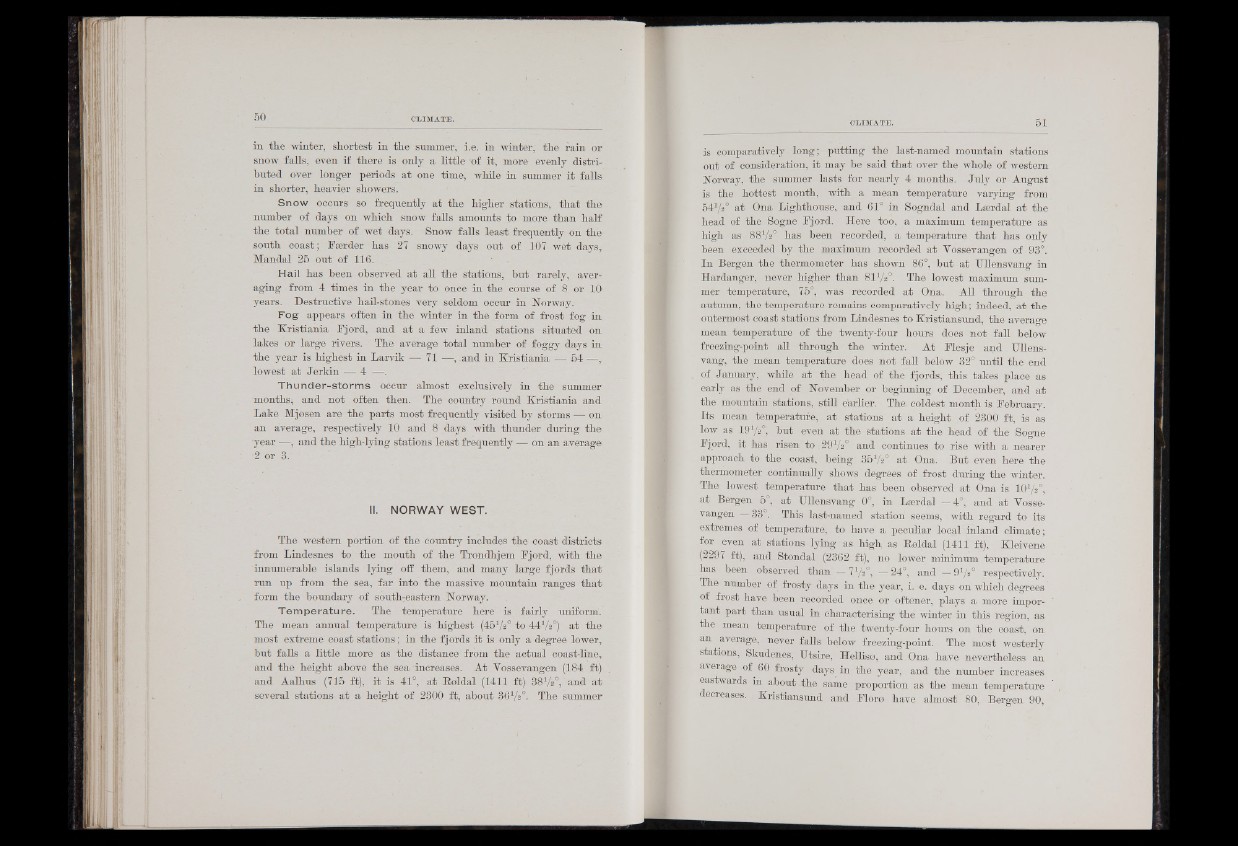
in the winter, shortest in the summer, i.e. in winter, the rain or
snow falls, even if there is only a little ‘of it, more evenly distributed
over longer periods at one time, while in summer it falls
in shorter, heavier showers.
S n ow occurs so frequently at the higher stations, that the
number of days on which snow falls amounts to more than half
the total number of wet days. Snow falls least frequently on the
south coast; Fserder has 27 snowy days out of 107 wet days,
Mandal 25 out of 116.
Hail has been observed at all the stations, but rarely, averaging
from 4 times in the year to once in the course of 8 or 10
years. Destructive hail-stones very seldom occur in Norway.
F o g appears often in the winter in the form of frost fog in
the Kristiania Fjord, and at a few inland stations situated on
lakes or large rivers. The average total 'number of foggy days in
the year is highest in Larvik *g- 71 —, .and in Eristiania eS 54 jj|f|
lowest at Jerkin— 1 ' J’’
T h u n d e r - s t o rm s occur almost exclusively in the summer
months, and not often then. The country round Kristiania and
Lake Mjasen are the parts most frequently visited by storms S o n
an average, respectively 10 and 8 days with thunder during the
year —, and the high-lying stations least frequently S on an average
2 or 3.
II. NORWAY WEST.
The western portion of the country includes the coast districts
from Lindesnes to the mouth of the Trondhjem Fjord, with the
innumerable islands lying off them, and many large fjords tha t
run up from the sea, far into the massive mountain ranges th a t
form the boundary of south-eastern Norway.
T em p e r a tu r e . The temperature here is fairly uniform.
The mean annual temperature is highest (45Vs° to 44V2°) at the
most extreme coast stations; in the fjords it is only a degree lower,
but falls a little more as the distance from the actual coast-line,
and the height above the sea increases. At Vossevangen (184 ft):,
and Aalhus (715 ft), it is 41°, at Reldal (1411 ft) 38Va°, and a t
several stations at a height of 2300 ft, about 36Va°; The summer
CLIMATE.
is comparatively long gf putting the last-named mountain stations
out of consideration, it may be said that over the whole of western
Norway, the summer lasts for nearly 4 months. July or August
is the hottest month, with, a mean temperature varying from
at Ona Lighthouse, and 61° in Sogndal and Lserdal at the
head of the Sogne Fjord. Here too, a maximum temperature as
high as 88V2° has been recorded, a temperature that has only
been exceeded by the maximum recorded at Vossevangen of 93°.
In Bergen the thermometer has shown 86°, but at TJllensvang in
Hardanger, never higher than 811/3°. The lowest maximum summer
temperature, 75°, was recorded at Ona. All through the
autumn, the temperature remains comparatively high; indeed, at the
outermost coast stations from Lindesnes to Kristiansund, the average
mean temperature of the twenty-four hours does not fajl below
freezing-point all through- the winter. At Flesje and Ullens-
vang, the mean temperature does not fall below 32° until the end
of January, while at the head of the fjords, this takes place as
early as the end of November or beginning of December, and at
the mountain stations, still ehrlier. The. coldest month is February.
Its mean temperature, at stations at a height of 2300 ft, is as
low as I H1/»*, but even at the stations at the head of the Sogne
Fjord, it has risen to , 29V3® • and continues to rise with a nearer
approach to the coast, being 351/s° at Ona. But even here the
thermometer continually shows degrees of frost during the winter.
The lowest temperature that has been observed at Ona is lOVa9/
at Bergen 5°, at TJllensvang 0°, in Lserdal — 4°, and at Vossevangen
33°. This last-named station seems, with regard to its
extremes of temperature, to have a peculiar local inland climate;
for even at stations lying as high as Reldal (1411 ft), Kleivene
(2297 ft), and Stondal (2362 ft), no lower minimum temperature
has been observed than —71/2°,. <-t 24°, and — 91/a° respectively.
The number of frosty days in the year, i. e. days on which degrees
of frost have been recorded once or oftener, plays a more important
part than usual in characterising the winter in this region, as
the mean temperature of the twenty-four hours on the coast, on
an average, never falls below freezing-point. The most westerly
stations, Skudenes, Utsire, Helliso, and .Ona have nevertheless an
average of 60 frosty days in the year, and the number increases
eastwards in about-the same proportion as the mean temperature
ecreases. Kristiansund and Flore have almost 80, Bergen 90,